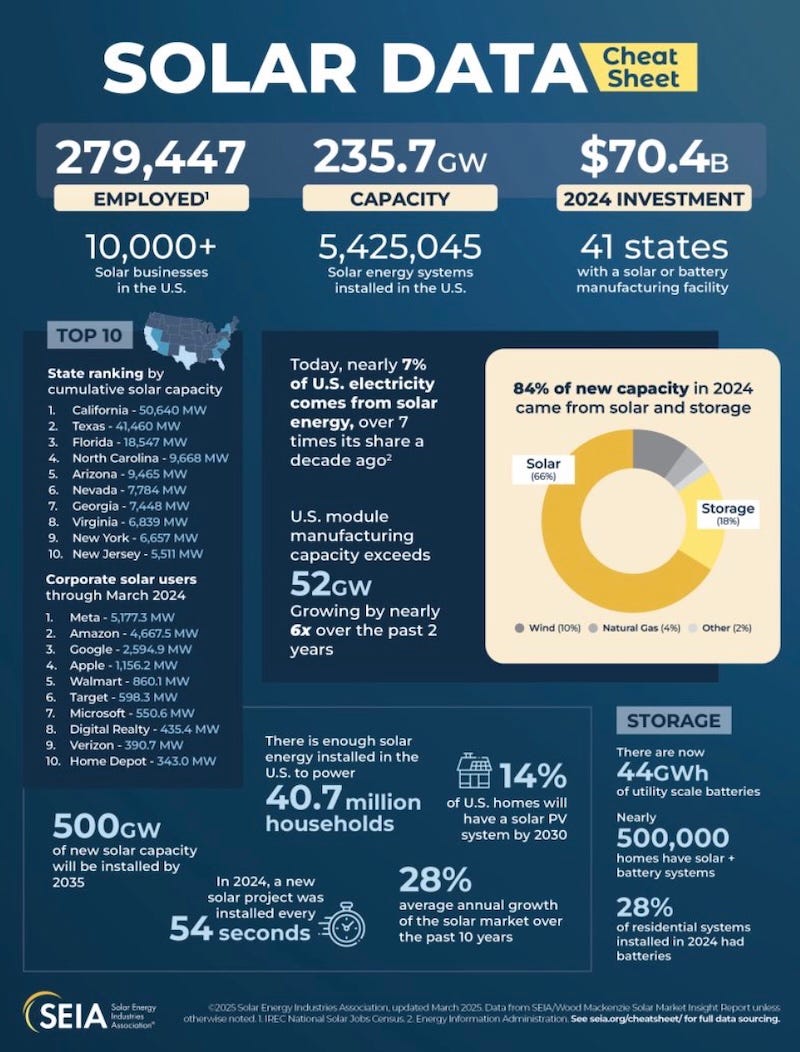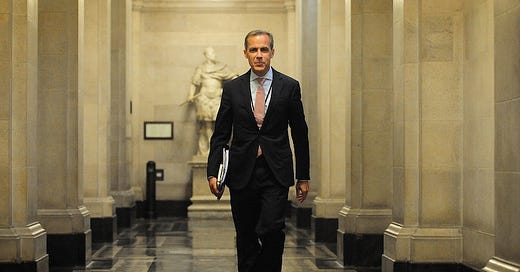Decision Time: One Energy Path Brings Carney the Big Wins He Needs. The Other One Doesn't.
There's still a lot of fog around Mark Carney's climate and energy strategy. It's creating anxiety in all directions. He needs to get this right, and 'all of the above' is not an option.
Prime Minister Mark Carney and his new cabinet took office Tuesday with some tough, momentous questions on their agenda, most of them still pointing back to the rogue regime waging economic war on Canada from the White House.
But as The Weekender first argued in March, after Carney won the Liberal Party leadership, there’s one fairly easy calculation the Cabinet can make that will set them on track to addressing that challenge. Not least by tackling the domestic vulnerabilities that were driving us apart until Donald Trump’s latest round of rolling outrages pulled us back together.
What’s the cheapest, quickest way to deliver the reliable, affordable energy Canadians need, while boosting domestic manufacturing, driving down climate pollution, and restoring public confidence that our governments can actually deliver on their promises?
If our political leaders answer that question seriously and follow the evidence where it leads, it will bring them directly to a low-carbon energy path that begins with:
• Drastically increasing the energy efficiency of everything;
• Replacing fuels with electricity across a large swath of the economy while decarbonizing the electricity system;
• Seizing the urgent opportunity to rapidly drive down methane emissions, whether or not fossil companies are serious about getting with the program;
• Pairing the rise of renewables and energy efficiency with a managed phaseout of oil, gas, and coal.
A least-cost energy strategy that factored in the fully-loaded cost of climate change would give us a lens for assessing every new pitch for Canada’s energy future—whether it’s a deep energy retrofit program, a local battery storage system, a solar or wind farm, a $100-billion nuclear megaproject, or the ridiculous demands for new pipelines in all directions, hatched by the fossil fuel industry and voiced by the former industry lobbyist they’ve since installed as Alberta’s premier.
Pretty much without exception, an honest answer to this one, crucial question points back to low-carbon options that are practical, affordable, and ready to scale up. They don’t depend on carbon capture and storage technologies that their biggest boosters admit are a decade away from prime time, or expensive direct air capture (DAC) adventures that still emit more carbon than they reduce. They won’t either fry the planet when used as directed or saddle us with eons’ worth of dangerous nuclear waste.
For bonus points, they connect us to a burgeoning global clean energy economy—the same one Carney has in mind when he talks about diversifying our exports beyond one risky, unreliable trading partner.
180° of Speculation
Just as important, this line of thought takes us past the disconnect between statement and action—between the “what” and the “how” of government policy on climate, affordability, and everything else that matters. That gap has cut across all the major political parties for the last deeply performative decade and quite rightly sapped public confidence that anything much will ever get done.
Now, with Carney vowing to “do things that had not been imagined or thought possible, at a speed we haven’t seen before,” his team’s early energy choices will either put his government on a path to success, or make it immeasurably harder for them to get there.
But in the first 100 hours after the Cabinet announcement (heh, he wants to move fast, so no more of this ‘first 100 days’ stuff), we were left with 180° of speculation about where this government will come down on climate change and energy.
We had Carney knowledgeably described as “the most climate-literate PM we’ve ever seen, and maybe the most climate-literate leader among industrialized countries,” while telling CTV news his government will “change things at the federal level that need to be changed in order for projects to move forward”—including the federal Impact Assessment Act and the former Trudeau government’s long-delayed cap on oil and gas emissions.
We heard that newly-minted Energy and Natural Resources Minister Tim Hodgson, former head of Ontario power utility Hydro One, board member at oil sands producer MEG Energy, and Carney colleague at Goldman Sachs, will either be the fossil industry’s voice in Cabinet, the former business heavyweight and familiar face who can talk low-carbon sense to the oilpatch, or the steady hand who can make a national renewable power grid a reality.
We saw an emphasis on pragmatism and short-term success from a government that seems enamoured of carbon capture technologies that are nowhere near ready for prime time and new nuclear reactor designs that look great on PowerPoints, but have never been built in the real world.
All of which is a longabouts way of saying that no one can say for sure which lane Team Carney will choose, and you have to wonder whether they’ve decided yet. The next big milestones will be the template language in the PM’s mandate letters to ministers and the Throne Speech that King Charles is scheduled to deliver May 27.
That is, unless we hear anything sooner from Carney or his Cabinet about the climate imperatives he’s known and understood for a decade or more, and the clean energy choices that give him his only chance at tackling any of the other big-picture crises he’s taken on.
The Projects We Want to Speed Up
We’ve known for decades, not years, that there’s a smart, systematic way to run an energy transition. The fine details have shifted over time, but the basic prescription has not.
Start by drastically increasing the energy efficiency of everything.
Electrify key end uses like cars and other vehicles, home heating and cooling, and many industrial processes, now with the added reliability of affordable energy storage, while decarbonizing the electricity system.
Make it an absolute, top priority to phase out emissions of methane—the main component of natural gas, a climate-busting super-pollutant with 84 times the impact of carbon dioxide over a 20-year span, and our single best chance to achieve major climate gains by 2030.
Pay careful attention to the relatively few, more complicated energy uses—like air travel and some heavy industries—that aren’t so simple to decarbonize.
And, crucially, cut with both arms of the scissors by pairing the rise of renewables and energy efficiency with a managed phaseout of the oil, gas, and coal industries whose products are frying the planet when used as directed, while devastating local ecosystems and communities along the way.
With rapid emission cuts and deeper climate resilience as our top-line goals, the energy transition also delivers on the quicker business opportunities that industry has been demanding—even if those aren’t the opportunities the fossil lobby has in mind when it’s doing the demanding.
Even at relatively large scale, solar and wind farms are faster to approve and build than fossil fuel plants, pipelines, or nuclear reactors, largely because they have a far smaller physical and environmental footprint. They generally come in on time and on budget because, unlike the most mega of megaprojects, they aren’t too big to succeed.
Go behind the meter, to the realm of deep energy retrofits, home heat pumps, rooftop solar panels, solar+storage, and community microgrids, and you can afford to speed up the process even more, as long as developers know how to open real conversations with local communities and earn their support.
“The modular nature of solar and wind construction allows for faster development and more predictable construction timelines and costs at different scales,” Eyab Al-Aini, senior research associate, clean growth at the Canadian Climate Institute, told The Weekender in an email earlier this year. “Unlike gas turbines or nuclear generation, where pressure on a few suppliers can limit choice and stretch timelines, the distributed nature of solar equipment manufacturing lowers overall project execution risks.”
Al-Aini added that smaller projects can face lighter permitting requirements because they often “bypass the transmission planning process, can leverage existing onsite assets (roofs, permits),” while benefitting from fewer technical reviews and bypassing long waits to connect to the grid. And behind-the-meter solar and wind, “especially when combined with storage, can both reduce overall site energy use from the grid and also be a source of power during peak demand.”
Note that every megawatt of peak power demand a community can save through energy efficiency or generate behind the meter is a megawatt that needn’t be supplied by methane-intensive gas plants that provincial premiers like Doug Ford are so intent on building in places like Ontario.
The Road Not Taken
Smaller-scale energy isn’t quite as simple as I’m making it sound, and decades ago, a decision on which kind of complexity to embrace was instrumental in bringing us the oil sands industry as we know it today.
When I worked at the late, lamented Canadian Renewable Energy News, like any other early 1980s news outlet in a world before PDFs, we received our share of news leaks in hard copy, delivered in (literal or metaphorical) plain brown envelopes. One draft memo, printed on the recycled map paper that signposted its origins in the then Department of Energy, Mines and Resources, compared the costs and benefits of subsidizing a heavy oil upgrader in Alberta against an equivalent investment in a national home insulation program.
Its conclusions were stunning: The insulation plan would save more energy than the upgrader would produce, creating more jobs that were more evenly distributed across the country. But federal bureaucrats were said to be petrified at the thought of staking the success of their decision on millions of individual, local choices, rather than a single, high-stakes negotiation among first ministers.
You know where that story ended. The upgrader went ahead, and to this day, Canada and especially Alberta are overly dependent on the boom-and-bust industry that received that initial infusion of government largesse, and has been steadily polluting the countryside and our national politics ever since.
New Pipelines Would Need Massive Subsidies
But now, with Trump threatening Canada’s very existence as a sovereign country, that history points to another advantage in accelerating the kind of energy projects we need and want. The ones that increase community control rather than obliterating it and reduce greenhouse gas emissions rather than driving them through the roof.
From the moment the current occupant of the White House began trumping up his baseless case for tariffs and economic annexation, his allies and paymasters in the oil and gas industry knew what to do. The partly American-owned companies in the Alberta oilpatch, many of which no doubt contributed to the industry’s lavish and “breathtakingly corrupt” investment in bringing Trump back to power, immediately dusted off every pipeline megaproject they’d failed to push through over the last decade. Suddenly, industry lobbyists and elected officials were touting carbon bombs like the Energy East and Northern Gateway pipelines as the path to our economic salvation, even the key to our national identity.
When we last looked in on this topic in March, Globe and Mail columnist Adam Radwanski had a good idea of how those questions would be answered. The very obvious absence of any private investors tripping over each other to build new pipelines:
…suggests enormous subsidies would be required to attract the capital, if not outright government ownership. The rationale would have to be that given the security dangers posed by Mr. Trump, Canada can no longer rely on oil from the U.S., or flowing through the U.S., to supply eastern provinces.
But as then-energy and natural resources minister Jonathan Wilkinson pointed out at the time,
there is no way a pipeline would be completed in less than five years. That wouldn’t make it much help with the threat posed this decade by Mr. Trump. And by then, the shift toward electric vehicles—which Mr. Trump may slow, but won’t stop outright as those vehicles get cheaper—could mean less oil is needed.
Even if subsequent events have blunted the International Energy Agency’s projection that oil demand will peak this decade, Radwanski added, “placing a huge bet against it happening next decade isn’t wildly appealing.” Carney’s Quebec lieutenant, former environment and climate minister Steven Guilbeault, made much the same point on Wednesday, the day after the PM’s CTV interview.
“I think before we start talking about building an entire new pipeline, maybe we should maximize the use of existing infrastructure,” Guilbeault told media, noting that the $34.2-billion taxpayer liability known as the Trans Mountain pipeline expansion is still operating below capacity. “And, the Canadian Energy Regulator, as well as the International Energy Agency, are telling us that probably by 2028-2029, demand for oil will peak globally, and it will also peak in Canada.”
It All Comes Back to Community
Even or especially as we face down an existential external threat, we have to be honest about a legacy of resource extraction projects—from fossil fuels and pipelines to mining and forestry—that have too often left communities behind and their land base indelibly altered. Changing the channel on that history begins with not repeating the same old, bad old practices of bulldozing projects through local objections, or accelerating approvals and permitting so fast that communities can barely catch their breath, much less assess the impacts and have their say.
If we’re joining together to protect Canada as a nation that is different and distinct, that cannot and must not mean deregulating ourselves out of the values—social and spiritual, economic and physical—that we’ve set out to protect.
Politicians across the spectrum have been tapping into a powerful vein of community pride and purpose. It’s playing out at the national level in response to an international threat. But it traces back to the people, places, and things we know and love—and so much of what we’re all scrambling to defend is local.
That means we don’t want an ExxonMobil subsidiary polluting Indigenous lands and withholding the information from communities for months, or an Australian coal magnate winning regulatory approval for a widely-hated megaproject in the Rocky Mountain foothills, any more than we support Elon Musk’s U.S. gigafactory dumping waste in the Nevada desert and harassing whistleblowers who try to tell the story.
It means holding clean energy projects to those same standards, even knowing that they start out delivering more benefits and fewer impacts than the fossil fuel developments they replace. And setting the expectation that renewable energy developers will consult pro-actively, listen attentively, and look at community input as an opportunity to maximize benefits, minimize impacts, and dodge major flaws in a project design before it’s too late—not just an exercise in box-checking.
We didn’t need Donald Trump to remind us that the energy transition is meant to be about building something better, not just replacing one set of crappy, corrupt industrial practices with another one. Now, Mark Carney and his Cabinet get to prove it, in a moment and on a scale where failure is not an option.
Mitchell Beer traces his background in renewable energy and energy efficiency back to 1977, in climate change to 1997. Now he and the rest of the Energy Mix team scan 1,200 news headlines a week to pull together The Energy Mix, The Energy Mix Weekender, and our weekly feature digests, Cities & Communities and Heat & Power.
Chart of the Week

Critics Slam Cost of Ontario SMR Plan, Question Dependence on U.S. Uranium
Oneida Battery Project, Canada’s Biggest, Goes Online Ahead of Schedule, Under Budget
Pipelines? CCS? Clean Energy? All of the Above? Carney Statements Fuel Anxiety, Optimism
Hydro‑Québec Unveils $10B Energy Efficiency Plan, Targets 3,000 MW of New Solar
Alberta Undercuts Investment, Creates Business Uncertainty by Freezing Industrial Carbon Price
Trump Promised to Help Big Oil. Its Revenues Plummeted.
Massive Blackout in Spain Shows Need for Grid Investment, Battery Storage, Experts Say
Ontario Grid Sees Highest Share of Emitting Power Since Coal Era
RBC Had Options, Critics Say, as Bank Defends Sustainable Finance Pullback
'Worst fears' confirmed as 2 people trapped by wildfire die in southeastern Manitoba: RCMP (Canadian Broadcasting Corporation)
Renewable Energy Investment Soars With Record Highs: Why Companies Are Going All In For the Next 5 Years (Michigan News)
White House bars agencies from using social cost of carbon (E&E News)
‘Numbers in the Trillions’: Fossil Fuel Producers on Hook for Climate Harms (Drilled News)
Researchers develop first-of-its-kind financial tool to hold powerful companies accountable: 'A game-changer' (Yahoo! Finance)
A New Handbook Shows Churches How to Hold Fossil Fuel Actors Accountable (Inside Climate News)
Driest spring in over 100 years continues as UK farmers hope for ‘meaningful’ rain (The Independent)
Why Air Products Investors Revolted Against Clean Hydrogen (Heatmap News)
Backer of Australia’s two biggest green hydrogen projects claims “breakthrough” on costs (Renew Economy)
German Economics Minister Reiche urges construction of new gas-fired power plants (Zeit Online)
Coal Loses Its Grip as Poland Records Historic Energy Shift (Warsaw Business Journal)
‘Cybersecurity is a real problem, but the Reuters report should be taken with a grain of salt’ (PV Magazine)








Nuclear power should never be found in the list for sources of clean energy - never! Anybody want Tritium in their drinking water? Tritium is only one of hundreds of deadly radioactive contaminants released from nuclear reactors and their cooling water, some lasting for hundreds of thousands of years. Check it out: [ https://wp.ccnr.org/troubles-with-tritium/ ]